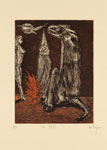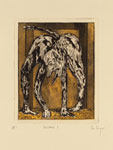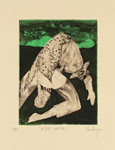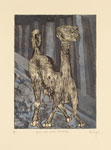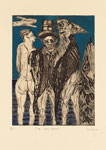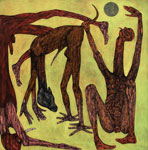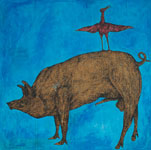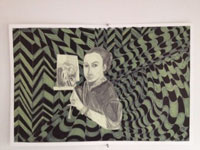Carlos Fragoso: Etchings and Paintings
November 30, 2012 - January 5, 2013
Opening Reception Friday November 30, 6-8 pm
Kathleen Cullen Fine Arts presents an exhibition of etchings by Carlos Fragoso, inspired, by the first paragraph of Dickens’s A Tale of Two Cities.
"It was the best of times, it was the worst of times, it was the age of wisdom, it was the age of foolishness, it was the epoch of belief, it was the epoch of incredulity, it was the season of Light, it was the season of Darkness, it was the spring of hope, it was the winter of despair, we had everything before us, we had nothing before us, we were all going direct to heaven, we were all going direct the other way - in short, the period was so far like the present period, that some of its noisiest authorities insisted on its being received, for good or for evil, in the superlative degree of comparison only." - Charles Dickens, A Tale of Two Cities
“Age of Foolishness” is a set of 15 prints combining the techniques of etching, aquatint and dry point. The prints are made from a single plate, background color first, the lines and aquatints, always in sepia, minutes later. There is neither black nor white in the series. The exhibition will include two recent paintings.
Artist Statement:
The current body of work was begun in 2007. These paintings and drawings feature human and animal figures in landscape and interior settings. Either alone or in groups, the figures do not tell a story. Rather, they form self-sufficient images with the power to shock, move, attract and repulse, without labels or explanations.
The work constitutes an emotional research into the underlying motivations of human actions and interactions. This investigation goes beyond the rational, culturally and socially accepted surface, and looks closely at the irrational, unconscious and primitive animal instincts that ignite passion, violence and desire.
The work draws upon the artist’s obsessions relating to personal experience (sex, dreams, living), to images (art works, photographs, magazines, newspapers), and words (poetry, music, literature). The work freely uses these sources, transforming them in the process.
Initially, creating a painting involves a vision but no plan or map to get there. The first step is to draw directly on canvas or paper with a brush and diluted acrylic paint. If an image is strong, then the artist tries to take control of it, refine it, adjust the proportions and make it stronger. Over time, the work may change significantly, become more complex, expanding and including more characters. Paintings can take months to finish, while some of the drawings may be done in hours.
This work demonstrates that if a work of art is strong enough in real emotion, and if it is visually successful and investigative, it will connect with the viewer, motivating their own personal inquiry.
Biography:
Carlos Fragoso paints dream-like scenarios, populated by humans, animals, and hybrids of both. His art examines the inner life of humanity, its instinctual urges and unconscious motivations, while critiquing the will to power and domination.
Fragoso, who was born in Rio de Janeiro, Brazil in 1954, had an interest in art from an early age. Although he took private art classes as a youth, and studied lithography and etching later on, he is essentially self-taught. He has developed both a deep connection to the history of painting and a method of working that combines sensitive drawing with materially expressive painting techniques.
In the 1970s, Fragoso produced gestural ink drawings that featured birds, anticipating the role of animals in his later work. He began exhibiting his paintings while still in college, graduating with a business degree in 1977. A formative experience for Fragoso was the six years he spent developing a rubber plantation in the state of Bahia. In that isolated setting, exposed to nature and a variety of animals, he worked on his art. Returning to Rio in 1985, Fragoso began a very productive period of creating and exhibiting his paintings. His work during this period involved surreal images with animals and humans in a variety of settings, ranging from interiors to abstract space.
Fragoso cites as painters who have influenced his work, Francis Bacon, Balthus, Max Ernst and Leon Golub. All of these painters explored psychological reality expressed through the human body. Like these painters, Fragoso creates imagined worlds, with figures that combine close observation and poetic invention. The titles of his works reveal this painter’s connection to modern art and literature. A very long naked figure who instead of a head has a sculptural cabinet of curiosities – his inner life – is titled Portrait and a Dream, after the Pollock painting. The Heroism of Cockroaches, with large insects advancing over dollar bills, draws its title from a Kafka essay. Summer Cannibals is named after a Patti Smith song.
After moving to Miami in 1990, Fragoso ran a business importing Brazilian limestone and granite for architectural projects. In 2007, he relocated to New York, and began an ambitious, ongoing series of large-scale paintings. These often allegorical works, at times measuring 11' long, confront human nature, and what the artist describes as its, “primitive animal instincts that ignite passion, violence and desire.” During the 2000s Fragoso has also produced drawings, some of which have served as the source of the paintings’ imagery.
Fragoso has shown his work extensively in solo exhibitions at Books & Books, Coral Gables FL, Galeria Claudio Gil Studio de Arte and Gallery of the Brazil-United States Institute, both in Rio de Janeiro. The latter show was named “Best Exhibition of 1986", and came with a travel prize to the Tamarind Institute in Albuquerque NM and New York. Group exhibitions include those at the Museum of Modern Art, Ministerio da Educacao, and the National Foundation for the Arts, all in Rio de Janeiro.
Back Room: Pam Glick
Inspired by displaced cultural figures, Glick creates playful paintings and drawings that combine illusion and the figure.
